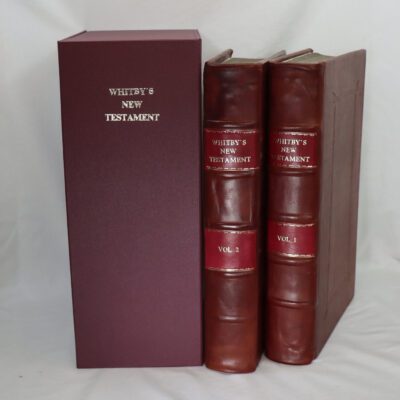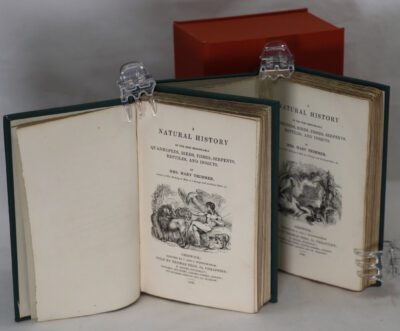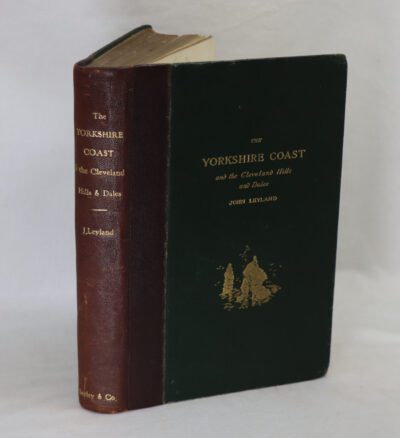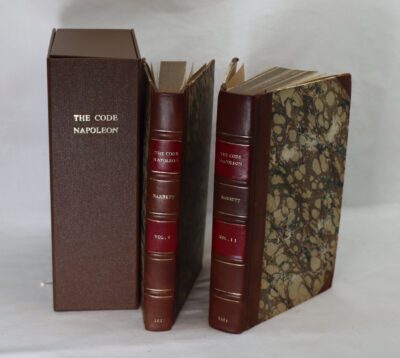Fair Maid of Perth. Sir Walter Scott.
By Sir Walter Scott
Printed: 1863
Publisher: Adam & Charles Black. Edinburgh
| Dimensions | 11 × 17 × 2.5 cm |
|---|---|
| Language |
Language: English
Size (cminches): 11 x 17 x 2.5
Condition: Fine (See explanation of ratings)
Your items
Item information
Description
Tan Leather binding with green title plate, gilt banding and lettering on the spine. Brown marbled boards. of a set.
The Fair Maid of Perth (or St. Valentine’s Day) is an 1828 novel by Sir Walter Scott, one of the Waverley novels. Inspired by the strange, but historically true, story of the Battle of the North Inch, it is set in Perth (known at the time as Saint John’s Toun, i.e. John’s Town) and other parts of Scotland around 1400.
St Valentine’s Day; or, The Fair Maid of Perth was published on 15 May 1828, by Cadell and Co. in Edinburgh and Simpkin and Marshall in London, the latter receiving 6000 copies in all. The price was one and a half guineas (£1 11s 6d or £1.57½). In the summer of 1831 Scott revisited the work for the ‘Magnum’ edition, making some textual changes and providing a few brief notes, but he was in poor health and many more changes and notes were introduced by J. G. Lockhart (with or without authorial input). Lockhart also provided the novel with an antiquarian and source-documenting introduction to replace Scott’s original discussion of work’s genesis. The work appeared posthumously in November and December 1832 as Volumes 42 and 43.
The standard modern edition of The Fair Maid of Perth, by A. D. Hook and Donald Mackenzie, was published as Volume 21 of the Edinburgh Edition of the Waverley Novels in 1999: this is based on the first edition with emendations mainly from the manuscript; the ‘Magnum’ material appears in Volume 25b (2012).
The fair maid of the title is Catharine Glover, daughter of a glovemaker in Perth, who kisses Henry Gow/Smith, the armourer, while he is sleeping, on Valentine’s Day. But Catharine has caught the eye of the Duke of Rothesay, and when Gow interrupts an attempted abduction, the armourer is drawn simultaneously into royal intrigue and highland feud.
The armourer, Henry Gow, had excited the jealousy of the apprentice Conachar by spending the evening with the glover and his daughter and was returning to their house at dawn, that he might be the first person she saw on St Valentine’s morning, when he encountered a party of courtiers in the act of placing a ladder against her window. Having cut off the hand of one, and seized another, who, however, managed to escape, he left the neighbours to pursue the rest, and was saluted by Catharine as her lover. The citizens waited on the provost, who, having heard their grievance, issued a challenge of defiance to the offenders.
Meanwhile, the King who occupied apartments in the convent, having confessed to the prior, was consulting with his brother, when the Earl of March arrived to intimate his withdrawal to the English Border, followed into the courtyard by Louise, and afterwards by the Duke of Rothesay, whose dalliance with the maiden was interrupted by the Earl of Douglas ordering his followers to seize and scourge her. Henry Gow, however, was at hand, and the prince, having committed her to his protection, attended his father’s council, at which it was determined that the hostile Clans Chattan and Quhele (“Kay”) should be invited to settle their feud by a combat between an equal number of their bravest men in the royal presence, and a commission was issued for the suppression of heresy. The old monarch, having learnt that his son was one of those who had attempted to force their way into the glover’s house, insisted that he should dismiss his Master of the Horse, who encouraged all his follies; and while Catharine, who had listened to the Lollard teaching of Father Clement, was being urged by him to favour the secret suit of the Prince, her other lover, Conachar, who had rejoined his clan, appeared to carry off her councillor from arrest as an apostate reformer.
The armourer had maimed the Prince’s Master of the Horse, Sir John Ramorny, whose desire for revenge was encouraged by the apothecary, Dwining. An assassin named Bonthron undertook to waylay and murder Henry Gow. On Shrovetide evening old Simon was visited by a party of morrice-dancers, headed by Proudfute, who lingered behind to confirm a rumour that Henry Gow had been seen escorting a merry maiden to his house, and then proceeded thither to apologise for having divulged the secret. On his way home in the armourer’s coat and cap, as a protection against other revellers, he received a blow from behind and fell dead on the spot. About the same time Sir John was roused from the effects of a narcotic by the arrival of the prince, who made light of his sufferings, and whom he horrified by suggesting that he should cause the death of his uncle, and seize his father’s throne.
The fate of Proudfute, whose body was at first mistaken for that of the armourer, excited general commotion in the city; while Catharine, on hearing the news, rushed to her lover’s house and was folded in his arms. Her father then accompanied him to the town council, where he was chosen as the widow’s champion, and the Provost repaired to the King’s presence to demand a full inquiry. At a council held the following day, trial by ordeal of bier-right, or by combat, was ordered; and suspicion having fallen on Ramorny’s household, each of his servants was required to pass before the corpse, in the belief that the wounds would bleed afresh as the culprit approached. Bonthron, however, chose the alternative of combat, and, having been struck down by Gow, was led away to be hanged. But Dwining had arranged that he should merely be suspended so that he could breathe and during the night he and Sir John’s page Eviot cut him down and carried him off.
Catharine had learnt that she and her father were both suspected by the commission; and the Provost having offered to place her under the care of The Douglas’s daughter, the deserted wife of the Prince, the old glover sought the protection of his former apprentice, who was now the chieftain of his clan. Having returned from his father’s funeral, Conachar pleaded for the hand of Catharine, without which he felt he should disgrace himself in the approaching combat with the Clan Chattan. Simon, however, reminded him that she was betrothed to the armourer, and his foster father promised to screen him in the conflict. At the instigation of his uncle, the Prince had been committed to the custody of the Earl of Errol; but, with the Duke’s connivance, he was enticed by Ramorny and the apothecary to escape to the castle of Falkland, and, with the help of Bonthron, was starved to death there. Catharine and Louise, however, discovered his fate, and communicated with The Douglas, who overpowered the garrison, and hanged the murderers.
The meeting of the hostile champions had been arranged with great pomp, with barriers erected on three sides of the Inch, in an attempt to keep spectators off the battlefield, and the Tay forming the natural fourth side to the north. The Gilded Arbour summerhouse of the Dominican Friary, which afforded those inside an excellent view of the Inch, was adapted into a grandstand for the King and his entourage. Henry Gow, having consented to supply Eachin (Conachar) with a suit of armour, volunteered to take the place of one of the Clan Chattan who failed to appear. A terrible conflict ensued, during which Torquil and his eight sons all fell defending their chief, who at last fled from the battle-ground unwounded and dishonoured. On hearing of Rothesay’s death, Robert III resigned his sceptre to his wily and ambitious brother, and later died broken-hearted when his younger son James was captured by the English king. Albany transferred the regency to his son; but, nineteen years afterwards, the rightful heir returned, and the usurper expiated his own and his father’s guilt on the scaffold. The warrants against Simon and his daughter, and Father Clement, were cancelled by the intervention of the Earl of Douglas, and the Church was conciliated with Dwining’s ill-gotten wealth. Conachar either became a hermit, or, legend has it, was spirited away by the fairies. Scotland boasts of many distinguished descendants from Henry Gow and his spouse the Fair Maid of Perth.
Sir Walter Scott, 1st Baronet FRSE FSAScot (15 August 1771 – 21 September 1832), was a Scottish historical novelist, poet, playwright and historian. Many works remain classics of European and Scottish literature, notably the novels Ivanhoe, Rob Roy, Waverley, Old Mortality, The Heart of Mid-Lothian and The Bride of Lammermoor, and the narrative poems The Lady of the Lake and Marmion. He had a major impact on European and American literature. As an advocate, judge and legal administrator by profession, he combined writing and editing with daily work as Clerk of Session and Sheriff-Depute of Selkirkshire. He was prominent in Edinburgh’s Tory establishment, active in the Highland Society, long a president of the Royal Society of Edinburgh (1820–1832), and a vice president of the Society of Antiquaries of Scotland (1827–1829). His knowledge of history and literary facility equipped him to establish the historical novel genre and as an exemplar of European Romanticism. He became a baronet “of Abbotsford in the County of Roxburgh”, Scotland, on 22 April 1820; the title became extinct on his son’s death in 1847.
Although he continued to be extremely popular and widely read, both at home and abroad, Scott’s critical reputation declined in the last half of the 19th century as serious writers turned from romanticism to realism, and Scott began to be regarded as an author suitable for children. This trend accelerated in the 20th century. For example, in his classic study Aspects of the Novel (1927), E. M. Forster harshly criticized Scott’s clumsy and slapdash writing style, “flat” characters, and thin plots. In contrast, the novels of Scott’s contemporary Jane Austen, once appreciated only by the discerning few (including, as it happened, Scott himself) rose steadily in critical esteem, though Austen, as a female writer, was still faulted for her narrow (“feminine”) choice of subject matter, which, unlike Scott, avoided the grand historical themes traditionally viewed as masculine.
Nevertheless, Scott’s importance as an innovator continued to be recognised. He was acclaimed as the inventor of the genre of the modern historical novel (which others trace to Jane Porter, whose work in the genre predates Scott’s) and the inspiration for enormous numbers of imitators and genre writers both in Britain and on the European continent. In the cultural sphere, Scott’s Waverley novels played a significant part in the movement (begun with James Macpherson’s Ossian cycle) in rehabilitating the public perception of the Scottish Highlands and its culture, which had been formerly been viewed by the southern mind as a barbaric breeding ground of hill bandits, religious fanaticism, and Jacobite risings.
Scott served as chairman of the Royal Society of Edinburgh and was also a member of the Royal Celtic Society. His own contribution to the reinvention of Scottish culture was enormous, even though his re-creations of the customs of the Highlands were fanciful at times. Through the medium of Scott’s novels, the violent religious and political conflicts of the country’s recent past could be seen as belonging to history—which Scott defined, as the subtitle of Waverley (“‘Tis Sixty Years Since”) indicates, as something that happened at least 60 years earlier. His advocacy of objectivity and moderation and his strong repudiation of political violence on either side also had a strong, though unspoken, contemporary resonance in an era when many conservative English speakers lived in mortal fear of a revolution in the French style on British soil. Scott’s orchestration of King George IV’s visit to Scotland, in 1822, was a pivotal event intended to inspire a view of his home country that, in his view, accentuated the positive aspects of the past while allowing the age of quasi-medieval blood-letting to be put to rest, while envisioning a more useful, peaceful future.
After Scott’s work had been essentially unstudied for many decades, a revival of critical interest began in the middle of the 20th century. While F. R. Leavis had disdained Scott, seeing him as a thoroughly bad novelist and a thoroughly bad influence (The Great Tradition [1948]), György Lukács (The Historical Novel [1937, trans. 1962]) and David Daiches (Scott’s Achievement as a Novelist [1951]) offered a Marxian political reading of Scott’s fiction that generated a great deal of genuine interest in his work. These were followed in 1966 by a major thematic analysis covering most of the novels by Francis R. Hart (Scott’s Novels: The Plotting of Historic Survival). Scott has proved particularly responsive to Postmodern approaches, most notably to the concept of the interplay of multiple voices highlighted by Mikhail Bakhtin, as suggested by the title of the volume with selected papers from the Fourth International Scott Conference held in Edinburgh in 1991, Scott in Carnival. Scott is now increasingly recognised not only as the principal inventor of the historical novel and a key figure in the development of Scottish and world literature, but also as a writer of a depth and subtlety who challenges his readers as well as entertaining them.
Want to know more about this item?

Related products
Share this Page with a friend












